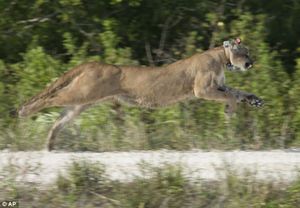
stories of wild animals being returned to their natural habitat? I
know I have, not only because they make me feel all warm inside, but
it also helps to restore thoughts that humanity might still exist.
However next time you see a story like
this, take the time to read the comments that others have posted. See
a pattern? Almost every last one is about the collar now around the
neck, or some bright tag that hangs on its ear like an earring.
Every time I see comments like this I
know that those people did not take the time to either think about
science or even the rules of hunting in that state.
One of the best examples that I ever
saw was back in early April on the website DailyMail.

into the wild. Yet it seemed like all anyone could talk about was,
“that big chunky collar around its neck.” One person ever
suggested that what the scientist should have done was implant a
microchip under the skin instead. Another even complained about the
bright pink ear tag that it now sported as it ran away.
This shows more than anything that
those who do not know, assume. A microchip, like the one your cats
and dogs have, is only good if you can wave the wand over the animal.
More importantly you have to be really close and wild animals are not
likely to let you get that close. The collar is in actuality a radio
transmitter that will allow scientists to track the animal by looking
for its specific frequency. The bright pink ear tag, lets them know
just from a glance that the animal has been caught before and where
information can be found. Even then, if a hunter did kill it not only
would they be fined but they could also go to jail, at least in
Florida.
It is simple things like this that show
how many people do not know what scientists are actually doing to
track, learn, and release wild animals back into their natural
habitat. I remember talking with a PhD student from school. She was
complaining that she had found a collar that could be worn by the
Ocelot and even then detach itself after a certain time. However,
before she could even think of implementing them into her research a
committee had to decide if it was humane enough. They said no, but
according to her it could have, even should have, gone her way.
All of this came to a head for me
months ago when I remembered a book my dad wrote when I was younger,
mostly about technology and how it shrinks over time. “The more
advanced technology gets, the smaller it needs to be.” he would
tell me. I have seen it on TV for myself. Years ago I would watch as
scientists were only putting tracking collars onto animals that were
a few hundred pounds or over. Now, not only are they able to put them
on birds, but they are also smaller, more streamlined, less likely to
get in the animals way, and many are not that chunky.

one point when he was comparing himself to another colleague who
studied similar animals. The colleague had to get up early, like 3 or
4 am, to try and track down one his birds to input data onto a
computer so that he could then go back and analyze it. While my
teacher could wake up at a reasonable time get some coffee and the
download where his birds had been from his computer remotely. The
difference was the type of radio transmitter they used and how old
they were.
All this means to me is that I have
been able to see improvements in technology, covering my field, and
that many people do not understand exactly what scientists are doing.
They see one thing, get a few facts and then make assumptions that
could one day be the difference between the animal thriving or going
extinct.










